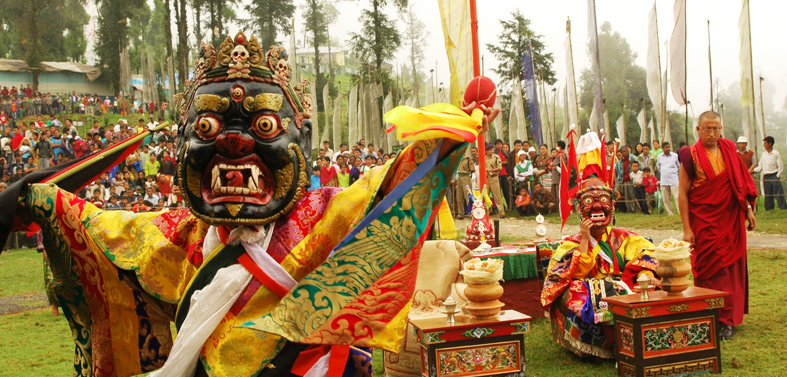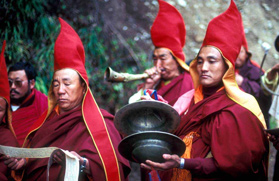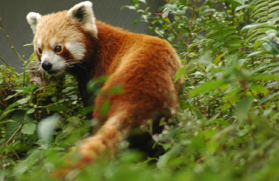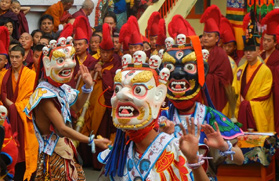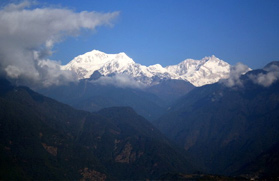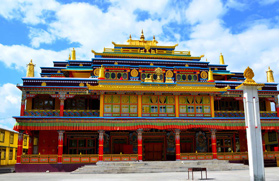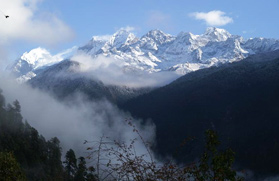Sikkim Cultural Tour
Photo Gallery
Being a perfect fusion of various communities, cultures and religions, Sikkim has Hindu temples, Churches, Mosques, Buddhist monasteries, and Sikh Gurudwaras. A fast developing society, Sikkim, has Lepchas, Bhutias and Nepalese as predominant communities. This article reflects on the various cultural aspects related to Sikkim.
People:
The people of Sikkim are known for their pleasant and sweet nature. Plainsmen from various other parts of India such as Bihar, West Bengal, Delhi and South India have also settled in Sikkim owing to their businesses and government jobs. An excellent specimen of harmony, Sikkim has hardly seen any communal violence. Lepchas are believed to be the original residents of Sikkim while the Bhutias are of Tibetan origin. At present, Nepalese (who migrated from Nepal) are the principal community in Sikkim who account for 80 % of the total population. Gurung, Chettri, Bahun, Limboos, Rai, Tamangs, Newaris and Marwaris are some of the other communities residing in various parts of Sikkim.
Cuisines:
Major cuisines of Sikkim include both vegetarian and non-vegetarian. People of Sikkim, like people of all other states in Northeast India, love eating rice. Since a large portion of the population in Sikkim is Nepalese, Nepalese dishes are famous here. Various Indian, Chinese, Tibetan and Bhutani cuisines are also famous in Sikkim. Traditional Momos and Thukpa (a noodle based soup with meat or vegetables) are easily available everywhere in Sikkim. Phagshapa (a strip of pork fat stewed with dried chillies and radishes), Kinema, Gunndruk and Sinki, Chhurpi, Mesu, Tama, Masauyra, Khalo Dal, Saelroti, Pakku, Kodo ko roti, Phulaurabh, and Chambry are other popular cuisines of Sikkim.
Languages:
Sikkim is a multi-lingual state with Nepali being the most widely spoken language. Around 62 percent of the people speak Nepali in Sikkim. English and Hindi are also understood by a large mass in Sikkim. However, English is mostly spoken in municipal areas, and as medium of instruction in Sikkim. Bhotia, the local language in Sikkim, is spoken by people who have migrated from Tibet. Tibetan, Limbu, Sherpa and Lepcha are the other significant languages spoken in Sikkim by different ethnic groups. Plainsmen from various parts of India speak their respective regional languages.
Religions and festivals:
Majority of the population of Sikkim consists of Hindus (about 61 percent) followed by Buddhists who are 28 percent of the population. All the Hindus in Sikkim are migrants from Nepal and follow Hindu rituals. 6.6 percent of people of Sikkim follow Christianity and 1 percent people follow Islam. Sikkimese people celebrate all the festivals with love and joy. Losar, Loosong, Saga Dawa, Lhabab Duechen, Drupka Teshi and Bhumchu are the major festivals which are celebrated by the Buddhists. During Losar, which is Tibetan near year, educational institutes and offices are closed for one week. Eid-ul-Fitr and Muharram are celebrated by Muslims of Sikkim.
Art and Craft:
People of Sikkim are born with a special talent of craft-making. Wood carving, carpet making, handloom, mask making, thangka painting are the main art and craft work in Sikkim. Prosperity of the Sikkimese culture truly reflects in its quality handicrafts. These handicrafts are easily available in roadside shops.
Music and Dance:
Different tribes and castes of Sikkim have their own different dance styles. Nepalese people of Sikkim perform Maruni dance, Bhutias perform Lu Khangthamo while Yak Chaam and Singhi Chaam are dance Tibetan form of dance. However, Mask dance is the most popular dance form in Sikkim. It is divided into various forms which are performed on different festivals.





